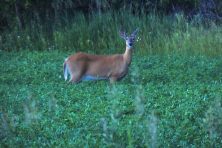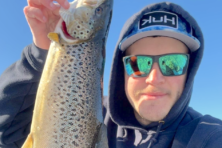WILD THINGS: Bring Back Deer Tags?
- Share
- Tweet
- Pin
- Share

Wisconsin deer hunters have seen more regulation changes in the past decade than at any other time period in history.
Some of those resulted in a loss of time-honored traditions, not to mention a big drop in income for hundreds of businesses that registered the thousands of deer brought in by hunters each fall.
In 2014, some hunters were selected to test a pilot electronic deer registration system. A year later, this long-standing Wisconsin tradition – hunters had been required to register deer in-person since 1953 – went 100 percent digital.
Far more convenient for some, others didn’t like the change, especially during the gun deer season when the majority of whitetails are taken. There would be no sharing of stories or shaking hands of a first-time or old-time hunter who scored, no photos of monster bucks, and no aging of the deer by Department of Natural Resources (DNR) biologists.
Next, backtags were eliminated in 2016. While the move was popular with many who didn’t like having to wear a “license plate” on their back due to noise or the possibility of forgetting or losing it, others believe the loss of the colorful, numbered tags – required since 1942 – helped law enforcement and property owners identify individuals, and were cool to collect.
A year later, provisions added to a budget bill after the archery season began removed a requirement for hunters to place a carcass tag on a deer or turkey, noting the date and time, sex, and whether it was an adult or young of the year.
Just like that, decades of tradition were gone, as well as the ability for conservation wardens to check to see if a deer being transported was properly tagged, a key part of the harvest-data picture.
Today, you can print your own tags – and you don’t even need to use them.
In spring of 2018, about one-third of Wisconsin counties passed local resolutions at the Conservation Congress Spring Hearings seeking a return of mandatory tagging of deer and turkeys. The count was better than 3-to-1 stating they’d like the DNR to require that the hunter must attach a carcass tag immediately, and have it remain on the animal while being transported.
Then in 2022 another spring-hearing question asked if respondents would support re-establishing in-person deer registration stations and carcass tags; it passed statewide by a two-to-one margin, but nothing has changed.
Has the elimination of in-person registration and attaching carcass tags made it easier for hunters to forget to register, or maybe choose not to?
That’s possible. Some will always poach, but it would seem the most accurate harvest data would come from physically tagging the deer, and registering it in-person.
Using data from surveys, DNR officials believe compliance with electronic registration is about 90 percent.
Many hunters say they like the convenience of being able to buy their licenses and register their harvests online, but at the same time say they don’t trust the online registration numbers.
The loss of community of the hunt that happened at registration stations is huge in my book. In a perfect world, I’d vote to make in-person registration required for the nine-day gun deer hunt, at minimum. But nine seasons have already passed with the modern way of doing things.
Is it too late to turn back the clock? Time will tell.
One Hunter’s Take
Long-time hunter and book author J.B. Sensenbrenner hunts both near his home in Door County as well as at a camp in Taylor County.
“Hunters missed seeing other deer kills at check-in stations,” Sensenbrenner said. “It was part of the lore. It was part of the community.”
Sensenbrenner said he believes far more than the DNR’s 10 percent estimate of deer aren’t being reported, and said that state Rep. Angie Sapik (R-Lake Nebagamon) is considering legislation to bring back tagging and in-person deer registration.
Sensenbrenner, who opened the door to this conversation by sending a photo of a wolf that a trail camera on his southern Door County property captured Dec. 20, is an author of a number of books, including Outdoor Legends, a 340-pager that features epic stories of nearly 50 individuals, including Davy Crockett, Ernest Hemingway and Chuck Adams.
It’s available at Yardstick Books in Algoma, and Howie’s Tackle and OtherWorlds Books in Sturgeon Bay. You can also contact the author for signed copies at [email protected].
Sensenbrenner said he donates a portion of the proceeds to the Door County Land Trust and The Nature Conservancy.
“This book was the hardest but most enjoyable book for me to write because of the research and time it required,” he said. “I wrote 70 drafts over 21 months. It took on a life of its own during the writing process in that it morphed from being about the greatest hunters to becoming about the greatest outdoor men and women who made a positive difference on the outdoors.”



